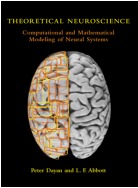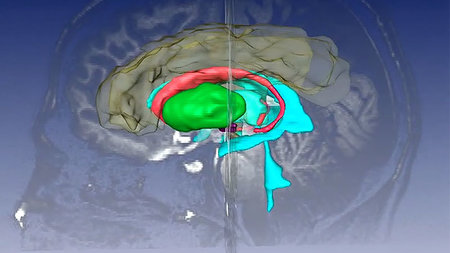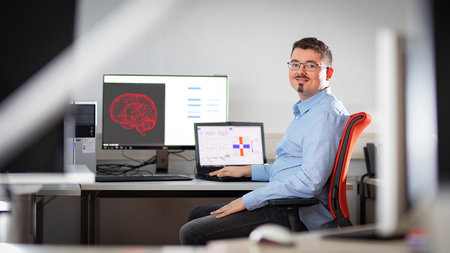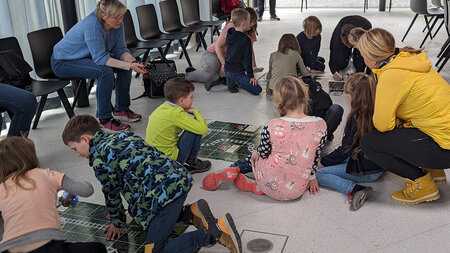WS2010
Neurocognition
Content
This course provides an introduction to neurocognitive computational modeling. Neurocognitive computational modeling is located at the interface between Psychology, Neuroscience, Computer Science and Physics. It is an important method for understanding the brain on the one side and trying to develop intelligent, adaptive systems on the other side. Starting with formal neuron models, I introduce a few network properties of neurons that are relevant for understanding the computations in the brain. This basic computational knowledge will then be used to build large-scale models of particular cognitive functions.
Goals: This module provides students with theoretical concepts of neuroscience as well as practical experience in neurocomputational modeling.
Remarks
Recommended courses: Basics in Math (Mathematik I to IV
Exam: Oral exam
Literature

Dayan, P. & Abbott, L., Theoretical Neuroscience,
MIT Press, 2001.
Syllabus
Introduction
The introduction motivates the goals of the course and basic concepts of models. It further explains why cognitive computational models are useful to understand the brain and why cognitive computational models can lead to a new approach in modeling truly intelligent agents.
Part I Model neurons
Part I describes the basic computational elements in the brain, the neurons. A neuron is already an extremely complicated device. Thus, models at different abstraction levels are introduced.
1.1 The neuron as an electrical circuitBiophysical models of single cells are constructed using electrical circuits composed of resistors, capacitors, and voltage and current sources. This lecture introduces these basic elements.
1.2 Integrate- and fire modelsIntegrate- and fire models model the membrane potential with a ODE, but do not explicitly model the generation of an action potential. The generate an action potential when the membrane potential reaches a particular threshold.
Exercise I.1: Integrate-and-fire model (2 units), Files: iandf.m,
makeie.m, normal.m
Solution I.1 Files: lsg1a.m, lsg1b.m
The membrane potential controls a vast number of nonlinear gates and can vary rapidly over large distances. The equilibrium potential is the result of electrostatic forces and diffusion by thermal energy and can be described by the Nernst and Goldman-Hodgkin-Katz equations.
1.4 Hodgkin and Huxley modelThe Hodgkin-Huxley (H-H) theory of the action potential, formulated 60 years ago, ranks among the most significant conceptual breakthroughs in neuroscience (see Häusser, 2000). We here provide a full explanation of this model and its properties.
Exercise I.2: Hodgkin and Huxley model (3 units), Files: hhsim_v3.1.zip
Solution I.2
The Hodgkin-Huxley model captures important principles of neural action potentials. However, since then several important discoveries have been made. This lecture presents of few important ones including more detailed models.
1.6 SynapsesThe synapse is remarkably complex and involves many simultaneous processes. This lecture explains how to model different (AMPA, NMDA, GABA) synapses and include them in the integrate-and-fire model.
Exercise I.3: Synapses (1 unit), Files: Ansatz3_a
Although it is generally agreed that neurons signal information through sequences of action potentials, the neural code by which information is transfered through the cortex remains elusive. In the cortex, the timing of successive action potentials is highly irregular. This lecture explains under which conditions such firing pattern can be modeled by a poisson process.
As explained in previous lectures the basic transfer from one neuron to another set of neurons relies on action potentials (spikes). However, for several phenomena is it sufficient the model just the spike rate of neurons and not the individual spikes. This lecture introduces to basic rate code models.
Additional Reading: Shadlen MN, Newsome WT. (1994) Noise, neural codes and cortical organization. Curr Opin Neurobiol. 4:569-79.
Part II Learning
2.1 Learning - Neural principlesLearning is a fundamental property of the brain. This lecture introduces into the most important concepts of synaptic plasticity and learning rules.
Exercise II.1: Learning (2 units), Files: Exercise4.zip
Solution II.1
Part III Network Mechanisms
3.1 Lateral and feedback circuits
Important properties in the brain emerge from the interactions between neurons. This lecture provides on overview of properties that appear in local, lateral and feedback circuits.
Exercise III.1: Rate coded neurons (1 unit)
Solution III.1
Additional Reading:
Grossberg, S (1988) Nonlinear Neural Networks: Principles, Mechanisms, and
Architectures. Neural Networks, 1:17-61. (only part 1-15)
Salinas E, Abbott LF (1996) A model of multiplicative neural responses in
parietal cortex. Proc Natl Acad Sci U S A, 93:11956-61.
3.2 Coordinate Transformations
Space can be represented in different coordinate frames, such as eye-centered for early visual processing and head-centered for acoustic stimuli. It appears that the brain relies on different coordinate systems to represent the space in our external environment. Thus, this lecture explains how stimuli can be transformed from one coordinate system to another.
Exercise III.2: Radial Basis Function Networks (1 unit), Files: Exercise6.zip
Solution III.2
Suggested Reading:
Cohen & Andersen (2002). Nature Rev Neurosci 3:553-562.
Pouget, A., and Snyder, L. (2000) Computational approaches to sensorimotor
transformations. Nature Neuroscience. 3:1192-1198.
Deneve S, Latham PE, Pouget A. (2001) Efficient computation and cue integration
with noisy population codes. Nat Neurosci., 4:826-31.
Pouget A, Deneve S, Duhamel JR. (2002) A computational perspective on the neural
basis of multisensory spatial representations. Nat Rev Neurosci., 3:741-7.
Part IV Systems
Perhaps our most important sensory information about our environment is vision. This lecture explains the first pre-cortical processing steps of visual perception.
The first cortical processing of the visual modality takes place in area V1, also called striate cortex. This lecture introduces into the receptive fields of neurons in V1 and explains what kind of information V1 encodes.
Exercise IV.1: Gabor Filter (1 unit), Files: Exercise7.zip
Additional Reading:
Adelson, E. H., Bergen, J R. (1985): Spatiotemporal energy models for the perception of motion.
J. Opt. Soc. Am. A/Vol. 2, No. 2 February 1985, 284-299
Beyond area V1, one pathway in the brain (ventral pathway) is particularly devoted for visual object recognition. This lecture explains the architecture of this pathway and how it implements object recognition.
Exercise IV.2: Object Recognition and HMAX (1 unit), Files: Exercise8.zip
4.4 Attention
Attention describes mechanisms in the brain that allow to shift processing resources, e.g. for visual attention to process particular locations, features or objects. This lecture introduces into the principles, the neural mechanisms and brain areas involved in visual attention.
Additional Reading:
Itti, L., Koch, C., Niebur, E. (1998): A Model of Saliency-Based Visual Attention for Rapid Scene Analysis. IEEE Transactions on Pattern Analysis and Machine Intelligence, vol. 20, no. 11, november 1998, 1254-1259
Itti, L., Koch, C. (2000): A saliency-based search mechanism for overt and covert shifts of visual attention. Vision Research 40 (2000) 1489-1506
4.4.4 The systems level of attention
Additional Reading:
Hamker, F. H. (2005) The Reentry Hypothesis: The Putative Interaction of the
Frontal Eye Field, Ventrolateral Prefrontal Cortex, and Areas V4, IT for
Attention and Eye Movement. Cerebral Cortex, 15:431-447.
Hamker, F. H. (2005) The emergence of attention by population-based
inference and its role in distributed processing and cognitive control of
vision. Journal for Computer Vision and Image Understanding, 100:64-106.
Hamker, F. H., Zirnsak, M. (2006) V4 receptive field dynamics as predicted
by a systems-level model of visual attention using feedback from the frontal
eye field. Neural Networks, 19:1371-1382.





